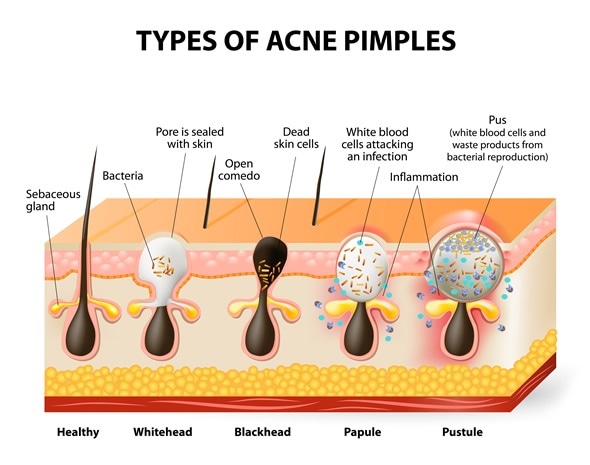Acne is an inflammatory skin problem which occurs at many ages and in both sexes. It is most common, however, during adolescence, and is thought to be due to the fluctuating hormone levels at this time, which affect sebum production and recycling. It is mediated by many inflammatory chemicals, including lipids and cytokines. When bacterial infection is superimposed on this phenomenon, other mediators are released which aggravate the condition.

Types of acne pimples. Healthy skin, Whiteheads and Blackheads, Papules and Pustules - Image Copyright: Designua
The pilosebaceous unit is the location of the pathognomonic acne lesion. It consists of a fine canal leading down from the skin surface into the dermis, lined by keratin-producing cells (keratinocytes), which produce the keratin fibers of which each hair is made.
Each follicle gives rise to one hair, which emerges through the skin pore (follicle orifice). A sebaceous gland is attached to each follicle, which produces the oily secretion called sebum. The sebum leaves the hair follicle carrying with it dead keratinocytes and other debris.
The basic lesion of acne is the comedo. This is a plugged and swollen hair follicle. It may be open to the skin surface or closed off by the overlying skin. In the open comedo, the sebum is exposed to the air, which causes oxidation of the fats and darkening of the most superficial part of the comedo. The keratinocytes in the follicle also produce pigmentation which contributes to the dark color. These lesions are also called blackheads. The follicle wall is intact.
Papular Acne
Acne may take the form of papules, or small raised reddish bumps on the skin. These are often painful and result from infection of the comedo by Propionibacterium acnes, a bacterial species which normally colonizes the skin. When large numbers of papular spots are present, the acne may be classified as moderate or severe.
Pustular Acne
Some people with acne present with small white or yellow spots surrounded by a swollen reddish painful area, which is an infected and inflamed hair follicle with the contained sebum. The pus points at one spot on the overlying skin, which forms the white dot. Papules and pustules often occur together. When they are clustered in significant numbers, the individual is said to have moderate to severe acne. Pustular acne is part of the disease category called inflammatory acne.
Nodular Acne
Nodules are formed as larger and more solid lesions which lie within the dermis of the skin, and are painful. They are also more difficult to treat. This is also considered to be part of inflammatory acne. The nodules are deeper within the skin and rarely point to the surface.
Management
Mild to moderate papulopustular acne is treated with topical retinoids such as adapalene, tazarotene and tretinoin. These are used as creams or gels, or in microsphere form, to lyse comedos and induce maturation of the intrafollicular keratinocytes. They are vitamin A derivatives. Their application prevents overshedding of the epithelial skin cells, and thus prevents their obstruction of the follicle with cells. They also decrease inflammation in and around the follicle. The main adverse effect is skin irritation, which may be overcome by moisturizing the skin, or by using different formulations such as the microsponge. These are usually used in combination with benzoyl peroxide and topical antibiotics such as erythromycin or clindamycin.
Topical antibiotics, such as clindamycin or erythromycin, are used usually in conjunction with benzoyl peroxide or retinoids.
Other topical agents include azelaic acid, benzoyl peroxide with comedolytic and antibacterial properties, and sulfur which acts to suppress bacterial growth and dries out the lesions. Sodium sulfacetamide is also used for this condition.
Systemic antibiotics may be used instead of topical, along with retinoids and benzoyl peroxide, in moderate or severe papular or nodular acne. These include using doxycycline or minocycline, usually in the full doses used to treat other conditions. However, other dosage methods include using low concentrations to inhibit inflammation rather than infection, and sustained-release compounds to avoid side-effects caused by the high concentrations in blood following the ingestion of the drugs. Azithromycin has also proved effective, as has cephalexin. However, systemic antibiotics run the risk of encouraging the emergence of resistant strains as well as of facilitating other infections. Autoimmune reactions have also been linked to the use of minocycline.
Anti-androgen agents are used to treat moderate papulopustular acne. These include spironolactone, a potassium-sparing diuretic, which has a weak anti-androgenic effect and is useful in women with high levels of androgens.
Oral contraceptive pills containing a combination of estrogen and progesterone, such as ethinyl estrogen (EE) with norgestimate, or EE with norethindrone acetate, are used in moderate acne in women. They suppress the production of androgens which provoke acne flares.
Severe nodular acne requires the use of isotretinoin and systemic antibiotics.
References
Further Reading